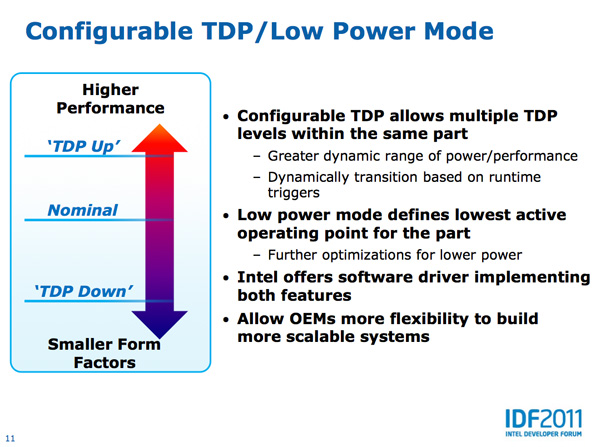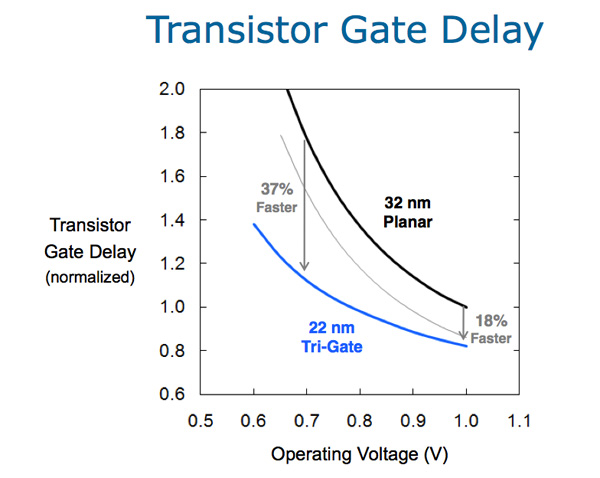Intel's Ivy Bridge Architecture Exposed
by Anand Lal Shimpi on September 17, 2011 2:00 AM EST- Posted in
- CPUs
- Intel
- Ivy Bridge
- IDF 2011
- Trade Shows
Power Efficiency Improvements
When Intel introduced its 22nm tri-gate transistors Intel claimed that it could see an 18% increase in performance at 1V compared to its 32nm process. At the same switching speed however, Intel's 22nm transistors can run at 75 - 80% of the voltage of their 32nm counterparts. Ivy Bridge's process alone should account for some pretty significant power savings. In addition to process however, there are a few architectural changes in IVB that will reduce power consumption.
Lower System Agent Voltages
Sandy Bridge introduced the System Agent, a name that used to refer to the uncore of a processor but now refers to the display output, memory controller, DMI and PCI Express interfaces. As of Sandy Bridge, the L3 cache was no longer included in the uncore and thus it wasn't a part of the System Agent.
The System Agent operates on a separate voltage plane than the rest of the chip. On Ivy Bridge Intel now offers even lower System Agent voltage options for the lower voltage SKUs, which in turn helps power optimize those SKUs.
More Accurate Voltage Characterization
Today Intel defines three different voltages for every Sandy Bridge CPU: LFM, nominal and turbo. LFM is the lowest frequency the CPU can run at (e.g. completely idle), nominal is the frequency it is specified to run at (e.g. 3.3GHz for a 2500K) and turbo is the highest available turbo frequency (e.g. 3.7GHz for a 2500K). Intel determines the lowest voltage possible for each one of those frequencies. Sandy Bridge obviously runs at more than just three frequencies, there are many more intermediate frequencies that it may run at depending on the current workload. The voltages at those intermediate frequencies are interpolated from the three points that I mentioned above.
With Ivy Bridge, Intel characterizes even more points along the frequency curve. Intel didn't reveal exactly how many points but it's more than three. A curve is then fit to the frequency/voltage data and depending on IVB's operating frequency a more accurate voltage point is calculated. The result from all of this seemingly simple work is a reduction in core voltage at these intermediate frequencies. Voltage changes have a cubic affect on power, so even a small reduction here can have a tangible impact. One of the points that wasn't previously characterized was max thread turbo. Ivy Bridge should be more power efficient in cases where you have all cores active.

Power Aware Interrupt Routing
This next feature is pretty neat. Ivy Bridge has logic to properly route interrupt requests to cores that are already awake vs. those that are asleep in their lowest power states. Obviously this approach can save a lot of power, however it may rob those active cores of some performance. IVB will allow prioritizing performance as well. Interrupt handling can thus be handled similarly to how it is today, or optimally for power savings.
Configurable TDP
I already wrote about what this is but if you missed our Pipeline post on it I'll briefly recap. All CPUs ship with a rated thermal design point (TDP) that tells OEMs what sort of cooling the chip requires. Traditionally that TDP value remained static and the CPU could do whatever it wanted but exceed that value. Ivy Bridge introduces configurable TDP that allows the platform to increase the CPU's TDP if given additional cooling, or decrease the TDP to fit into a smaller form factor.

The cTDP up mode is obviously for docked notebooks. You can imagine an Ivy Bridge notebook with an optional dock that could enhance the cooling capabilities of the machine. When undocked the notebook's processor would operate at a max TDP of 17W, for example, but toss it in a dock with additional cooling and the TDP would jump up to 33W. It's up to the OEMs to decide how they want to take advantage of this feature. It could be something as simple as a mobile dock with more fans, or something as complex as a modular water cooling solution with a bigger radiator in the dock. I haven't seen any concepts of systems that take advantage of Ivy Bridge's cTDP up support, but that's the theory.
What about cTDP down? Take the same 17W Ivy Bridge CPU from above but now drop the TDP to 13W, which in turn limits clock speed and voltage. Why would you want to do this? From the OEM perspective, Intel's TDP choices may seem arbitrary. Downwards configurable TDP allows OEMs to get a lower power configuration without forcing Intel to create a new SKU. OEMs can do this today through undervolting/underclocking of their own, but the cTDP down spec will at least give OEMs a guarantee of performance/power.
Configurable TDP obviously only applies to mobile Ivy Bridge. In particular the ultra low voltage and extreme edition parts will support cTDP. The cTDP values are listed in the table below:
| Ivy Bridge Configurable TDP | |||||
| cTDP Down | Nominal | cTDP Up | |||
| Ivy Bridge ULV | 13W | 17W | 33W | ||
| Ivy Bridge XE | 45W | 55W | 65W | ||
The most interesting are the 17W ULV Ivy Bridge parts as far as I'm concerned. Today you do sacrifice clock speed to get into the form factor of a MacBook Air. A clever OEM armed with Ivy Bridge might be able to deliver a cooling dock that would give you the best of both worlds: an ultra portable chassis on the go, and higher clock speeds while docked.











97 Comments
View All Comments
piroroadkill - Saturday, September 17, 2011 - link
I'd have liked a little more on this.. What's the source?I searched anyway, and found it is using thermal sampling. Presumably it's also seeded. Anyway, I thought it was of interest.
Jamahl - Saturday, September 17, 2011 - link
Don't you get tired of saying "intel is finally taking gpu performance seriously" every year? I do.JonnyDough - Monday, September 19, 2011 - link
I'd just like to say...=) Yes sir, I do.
imaheadcase - Saturday, September 17, 2011 - link
I heard when sandy bridge came out they was considering a GPUless version for enthusiasts who don't need it..is that something they will do eventually?I suspect its tied to the core, so not going to happen because of high costs. But wouldn't that save even more power/heat problems with that removed?
It just seems like its a mobile orientated cpu vs consumer. :D
DanNeely - Saturday, September 17, 2011 - link
With power gating if you're not using the IGP it doesn't consume any power; so the only thing they'd save on is die area by removing it.imaheadcase - Saturday, September 17, 2011 - link
Ah did not know that part. thanks.fic2 - Monday, September 19, 2011 - link
"I heard when sandy bridge came out they was considering a GPUless version for enthusiasts who don't need it..."Interesting since Intel did the exact opposite - put the only GPU with half decent performance into the enthusiast 'K' series.
JonnyDough - Monday, September 19, 2011 - link
The only people who would actually consider that are businesses and home users who don't play "real" games. :Pjjj - Saturday, September 17, 2011 - link
"I believe that x86 CPU performance is what sells CPUs today"That's not all that true anymore,there was a time when apps used by everybody required a fast CPU but that's not the case anymore nowdays..Just a few years ago playing HD content was a chalange on older systems but now ,if you look at usage paterns and what kind of perf is needed, the picture has changed. This is one of the reasons PC sales are not doing so great,there is no need to upgrade your system every 1-2 years.Even Windows is not driving system requirements up anymore.
In the consumer space GPU and battery life matter more now. Intel is trying to fight all this with lower power consumption, ultrabooks but that far from enough.If they want to survive the ARM "tsunami" (think about the financial part too here not just perf) , they got to push the software to be more demanding too and maybe the easiest is to do it on the GPU side -not in games.
MadMan007 - Saturday, September 17, 2011 - link
Intel's quarterly results say there is less to worry about than hyperbolic ARM domination headlines would lead one to think. One IDF slide showed large growth in emerging markets where the analysts aren't as able to get reliable data. Yes, PC upgrade cycles are longer, but that doesn't mean there is not net worldwide growth.There is room for growth in both areas, it's not a zero-sum game, and some things like mobile video consumption actually go hand-in-hand with faster beefy CPUs.